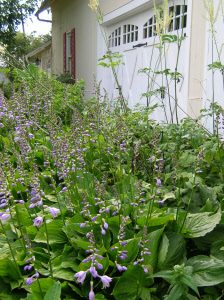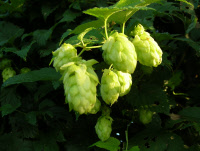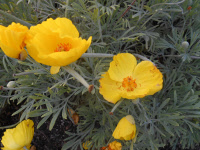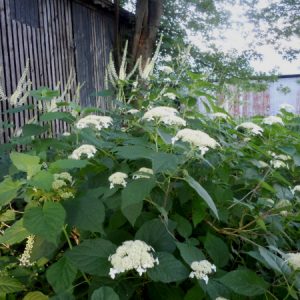Shop
Showing 401–408 of 785 results
-
Hosta lancifolia Lanceleaf Hosta Z 3-8
Lavender flowers in late summer to early autumn
Lavender flowers in late summer to early autumn
Size: 18" x 30"
Care: sun to shade in moist well-drained soil.
Native: Japan
Wildlife Value: attracts hummingbirdsJapanese called Hostas Giboshi and ate young leaves in spring as a vegetable. Hosta was named for Dr. Nicholas Host (1761-1834) the physician to the emperor of Austria. Hostas, cultivated since at least the 12th century in Asia, were first described for Europeans by Englebert Kaempfer in 1712, doctor for the Dutch East Indian Company on Dechima Island. . He taught Japanese interpreters astronomy and math and plied them with liquor in exchange for plants. H. lancifolia drawings date to 1690. Cultivated in the U.S. since the late 1800’s.
-
Hosta nigrescens Black hosta, Kuro-Giboshi in Japan Z 3-8
Lavender blooms in August-September up to 6’ tall; nearly 3’ tall vase-shaped mound of thick, cupped foliage. Resists slugs.
ARCHIVED
Note: This is a plant not currently for sale. This is an archive page preserved for informational use.
Lavender blooms in August-September up to 6’ tall; nearly 3’ tall vase-shaped mound of thick, cupped foliage. Resists slugs.
Size: 32” (flowers to 6’) x 74”
Care: sun to shade in moist soil
Native: fertile soil in valleys and forest margins in central and north JapanWidely grown in Japanese temple gardens. Young leaves were eaten in Japan to ward off famine.
Cultivated long before it was given a botanical name by Maekawa (1937/1940). The Japanese name Kuro Gibōshi translates to “black hosta.” This name dates to the floral work of Yokusai Iinuma (1910). Not actually black, but very dark-green and covered with a light gray, powdery coating initially, the leaves lose the gray covering and become very dark, polished green. The species name nigrescens also describes the dark coloring.
-
Hosta plantaginea ‘Grandiflora’ syn. H. plantaginea var. japonica, Funkia grandiflora Z 3-9
Fragrant white trumpets in late summer and early autumn
ARCHIVED
Note: This is a plant not currently for sale. This is an archive page preserved for informational use.
Fragrant white trumpets in late summer and early autumn
Size: 24” x 36”
Care: part sun, moist well-drained soil
Native: China
Wildlife Value: attracts hummingbirds
Awards: Royal Horticultural Society Award of Merit.Hosta was named for Dr. Nicholas Host (1761 – 1834) physician to the emperor of Austria and expert on grasses. H. plantaginea was a popular Chinese plant as long ago as the Han Dynasty (202 B.C. – 220 A.D.) Chinese used an ointment made from H. plantaginea to reduce inflammation and fever. M. de Guines introduced H. plantaginea to Europe when he sent it to the king of France in 1789. Gertrude Jekyll, (1848-1931) mother of the mixed perennial border, recommended H. plantaginea ‘Grandiflora’ to keep border gardens looking “full and beautiful.”
-
Hosta ventricosa Z 3-8
rich lavender bells periscope over heart-shaped leaves
In late summer rich lavender bells periscope over heart-shaped, prominently veined foliage.
Can not ship to: Maryland
Size: 20" x 36"
Care: Part shade in moist to moist well-drained soil. Tolerate Walnut toxicity
Native: China
Wildlife Value: attracts hummingbirds
Awards: Received England's Royal Horticultural Society Award of Merit.Japanese called Hostas Giboshi and ate young leaves in spring as a vegetable Hosta was named for Dr. Nicholas Host (1761-1834) the physician to the emperor of Austria. Hostas, cultivated since at least the 12th century in East Asia. Empress Josephine grew this at Malmaison. Redoute, Josephine’s botanical illustrator, painted H. ventricosa in 1805.
-
Humulus lupulus Hops Z 3-8
In August green turning to straw-colored papery hops dangle from this vigorous vine.
In August green turning to straw-colored papery hops dangle from this vigorous vine.
Size: 20' x 3'
Care: Sun to part shade in moist, humusy soil but tolerates dry shade.
Native: Europe
Wildlife Value: attracts Eastern comma & Red admiral butterfliesLupulus named for the Latin Lupis, meaning wolf “because the ancients had a notion that wolves hid themselves under this plant.” Gardeners Dictionary, 1768. Used for brewing since ancient times. Transported from continental Europe to England in 1524. Added to ale for flavor and as a preservative. In the late 1500’s Gerard claimed that hops seasoned ale and ”make it a physical drinke to keep the body in health, rather than an ordinary drinke for the quenching of our thirst… The buds or first sprouts which come forth in the Spring are used to be eaten in sallads… The floures are vsed to season Beere or Ale with, and too many do cause bitternesse thereof… The floures make bread light, and the lumpe to be sooner and easilier leauened, if the meale be tempered with liquor wherein they haue been boyled.” Russians crowned the heads of brides with its foliage to bring “joy, abundance and intoxication.” Others put dried hops into pillows to relieve insomnia. Imported to America by the mid 1600’s where it was used to provide shade and to make beer. Cherokee adopted hops to relieve pain caused by rheumatism. Grown by Jefferson.
-
Hunnemannia fumariifolia Goldencup, Mexican Tulip Poppy Z 9-11, Annual in colder areas
All summer and fall sunny, crepe-papery petals with jagged edges center around orange anthers all carried above thin-leaved blue-grey foliage.
OUT OF STOCK – EMAIL FOR AVAILABILITY
All summer and fall sunny, crepe-papery petals with jagged edges center around orange anthers all carried above thin-leaved blue-grey foliage.
Size: 6-12" x 6-12"
Care: sun in moist, well-drained to well-drained soil
Native: highlands of Mexico, TX, NM & AZDescribed and named by English botanist Robert Sweet (1783-1835) in The British Flower Garden vol. 3 (1828). Named for John Hunnemannia
-
Hydrangea arborescens ‘Annabelle’, Annabelle hydrangea, Snowball hydrangea Z 4-9
Flowering from late June to October, softball sized or bigger ivory heads fade to pale green. Toughest, easiest hydrangea to grow.
Flowering from late June to October, softball sized or bigger ivory heads fade to pale green. Toughest, easiest hydrangea to grow.
Size: 3-5’ x 3-5’
Care: Shade to sun in clay to well-drained soil. Prune back in early spring to 12-16” above the soil level.
Native: Southeastern US
Awards: Received England’s Royal Horticultural Society Award of Merit & Pennsylvania Horticultural Society Gold Medal Plant Award.Hydrangea is Greek from hydor meaning water and aggeion meaning vessel referring to the cup shaped fruit. The dried root was used as medicine – as a cathartic and diuretic. ‘Annabelle,’ the showy form, first collected around 1900 near Anna Illinois. The story of the ‘Annabelle’ hydrangea begins in southern Illinois near the town of Anna. In 1910, Harriet Kirkpatrick, went on a horseback ride along a wooded trail in Union County and noticed a beautiful native hydrangea with abnormally large, snowball-like blooms. Together with her sister-in-law, Amy Kirkpatrick, she went back to dig up the native shrub and transplant it into her yard in Anna. Neighbors and friends noticed the showy plant and the Kirkpatrick family shared specimens of the easily transplantable shrub, spreading its progeny throughout Anna and other towns in Illinois.
Given its wide local popularity, easy transplanting and culture, Mrs. Kirkpatrick contacted the Burpee Seed Company to see if there was interest in developing the new variety commercially. Unbeknownst to the Kirkpatrick’s, a recent improved cultivar of Hydrangea arborescens had been released in 1906. E. G. Hill brought the ‘Snowhill’ hydrangea into production from a wild specimen found near Yellow Springs, Ohio with similar abnormally large, snowball-like flowers, but an earlier bloom time.
So, for the next 50 years, ‘Annabelle would be an unnamed, but locally poplar cultivar, that was distributed by word of mouth throughout southern Illinois, finally reaching Urbana around 1935, based on the first recorded account.
It wasn’t until the 1960’s that the Kirkpatrick’s find gained the attention of University of Illinois professor and renowned plantsman, Dr. Joseph C. McDaniel. In 1960, McDaniel rediscovered ‘Annabelle’ by noticing it in cultivation in Urbana, IL. He traced it back to Anna, IL, collected samples for propagation, named the cultivar and released it for commercial production in 1962.
**LISTED AS OUT OF STOCK BECAUSE WE DO NOT SHIP THIS ITEM. IT IS AVAILABLE FOR PURCHASE AT OUR RETAIL LOCATION.
-
Hydrangea arborescens Z 4-9
Small white fertile flowers bloom in May-July in flattened clusters (corymbs to 2-6” across). Scattered continuing flowering may occur through September. Large sterile flowers usually appear in the cluster for a lacecap. Flowers give way to dehiscent seed capsules which ripen in October-November.
Small white fertile flowers bloom in May-July in flattened clusters (corymbs to 2-6” across). Scattered continuing flowering may occur through September. Large sterile flowers usually appear in the cluster for a lacecap. Flowers give way to dehiscent seed capsules which ripen in October-November.
Size: 3-5’ x 3-5’
Care: Shade to sun in moist well-drained to well-drained soil. Prune back in early spring to a foot above soil level.
Native: Southeastern U.S.
Wildlife Value: provides nectar and pollen to bees and butterflies and seeds to birds
Awards: Missouri Botanic Garden Plant of Merit.Hydrangea is Greek from hydor meaning water and aggeion meaning vessel referring to the cup shaped fruit. John Clayton (1694-1773) found this in the 1730’s in Virginian. This flowered in England for Peter Collinson (1694-1768) international merchant and active plant promoter, in 1746. Grown at America’s 1st botanic garden, Elgin Botanic Garden 1811.
**LISTED AS OUT OF STOCK BECAUSE WE DO NOT SHIP THIS ITEM. IT IS AVAILABLE FOR PURCHASE AT OUR RETAIL LOCATION.








